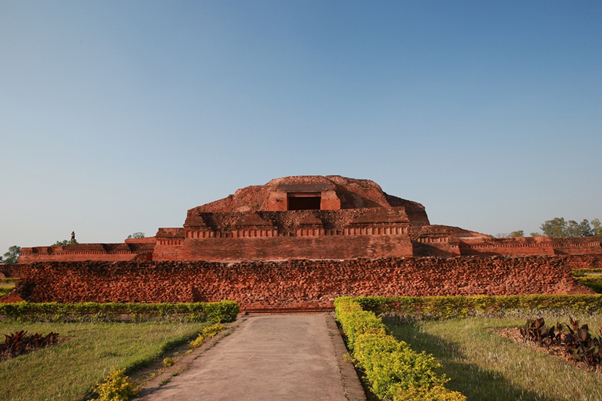Eight days (March 15th-22nd, 2015). The trip to explore Nalanda, Vikramashila, Sera and the surrounding areas. It was a trip to experience first-hand the monastic living tradition that exists to this very day. The descriptions of the activities of the Sangha in Nanhai Ji Gui Neifa Zhuan (南 海 寄 歸 內 法傳; A Record of the Buddhist Religion as Practised in India and the Malay Archipelago), translated by J. Takakusu, B. A., Ph. D, written by Yi Jing, a pilgrim monk from China, indeed raised a lot of question marks, especially in the seventh century CE, Yi Jing had lived for more than 10 years in Shili Foshi – or more precisely in the Muarajambi region, which has left him a deep impression, as he wrote in his notes: In the fortified city of Foshi, there reside thousands of monks who study all subjects as covered in Madhyadesa, India. He also advised that people intending to go to India should live and study in Foshi for one or two years.
At present, the remains of the Muarajambi Complex do not leave many stories behind that can be seen with the bare naked eye. However, the existing records and remains strongly suggest that the Muarajambi Complex was once the oldest and longest-standing center of learning in Indonesia, on par with and existed concurrently with the Nalanda University in India.
Sera Je and Sera Me
Departing from the Bangalore airport, India, we headed to the Buddhist learning complex (also known as a Monastic University), that is still active to this very day, namely Sera Je and Sera Me. Within this complex reside about 3,500 monks from Tibet, Sri Lanka and the surrounding areas of India. Their age range is astounding, ranging from small children under the age of 10, to adolescents and adults. To obtain a Geshe degree (equivalent to a PhD), the monks need to engage in rigorous studies for a period of 20-25 years – many of whom start from an early age. Their daily activities include prayers, attending lectures, reciting teachings, debate, performing karma-yoga (including various chores at the monastery such as cooking, sweeping, etc) and other activities. Since early dawn, the temple is already bustling with activities, where thousands of monks can be seen performing worship together. Some junior monks are running back and forth carrying jugs of butter-tea to be distributed to all participants of the service. Some lay people (who originate from other countries) are also present to participate in prostrations, or sitting outside the monastery to feel the energy of thousands of monks praying in unison.
The monks living in the monastery adhere to a fairly strict Vinaya discipline. Besides, they are not allowed to watch TV, play football or ride a motor-bike (except those in charge of administrative duties). The temple complex is dominated by the presence of large field situated in the four corners, which is strikingly identical to the design/structure of the Muarajambi Complex. Initially, this peculiar design seemed somewhat confusing, as to what the functionality of the large fields actually was. At dusk, it became apparent that the large fields function as the ‘debating arenas’ for reviewing the classes. The monks sat in groups: some in pairs and others in small groups, filling almost every corner of the field, where one party enthusiastically poses questions while the other party throws out the answers – pervading entire debate ground with the voices of intense debates. Debating here is used as an effective means to understand the deeper teachings, and not to compare the intelligence of one another.
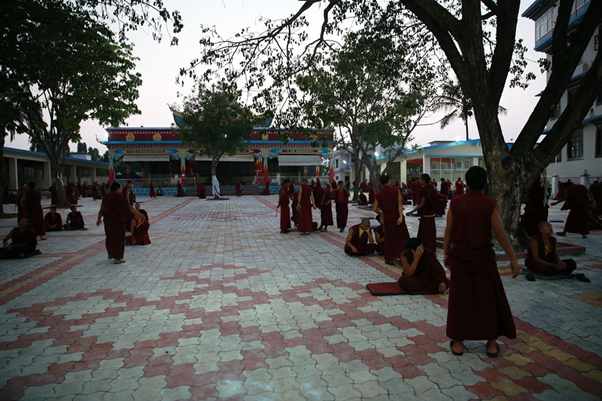 Debate ground at Sera Me, India
Debate ground at Sera Me, India
Nalanda
After spending a few days in Sera to witness the study of Buddhadharma as a living tradition, we headed to Nalanda, which in the past constituted one of the largest centers of learning of Buddhism. Nalanda University is located in the province of Bihar, India, established in circa the 5th century CE. Equipped with dormitories, Nalanda is the first residential university in the world, where students from China, Korea, Sri Lanka, Indonesia and other regions came to study. In its heydays, there were more than 10,000 students and 2,000 lecturers/teachers at Nalanda. Remarkably, subjects taught at that time already included pancavidya: logic (hetuvidya), grammar/literature (sabdavidya), medicine (cikitsavidya), art (silpasthanavidya), and inner science (adhyatmavidya). It is said that the monks who intended to study at Nalanda would first complete ‘preparatory studies’ at Muarajambi, in order to learn the subjects in advance (similar to conducting preparations required to enter into Ivy League Universities), including Yi Jing.
To date, Nalanda still has the remains of podiums, yards, wells and irrigation canals, ponds, and arrangement of bricks that previously served as rooms. Included also is a three-layered ladder that symbolizes the three dynasties: Gupta, Harshavadan and Pala.
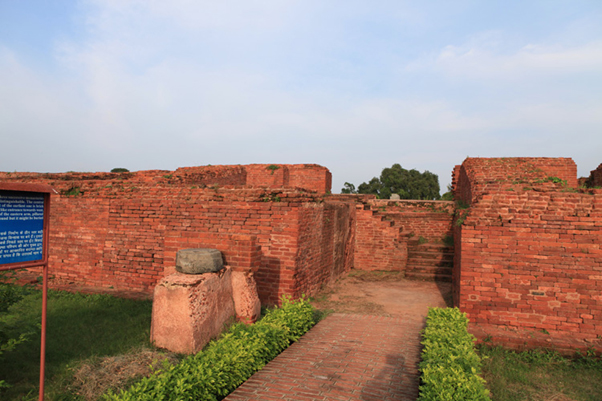 Nalanda Mahavihara, Bihar, India
Nalanda Mahavihara, Bihar, India
Xuan Zang
Within the Nalanda Mahavihara complex stands the Xuan Zang Memorial Hall, which was the result of a joint cooperation between India and China. Determined to receive Buddhist teachings from authentic sources, Xuan Zang set out on a journey to India and spent several years in Nalanda, where he studied and taught. As a result, he took back with him numerous Sanskrit manuscripts, which he then translated into Chinese language. Thanks to his travels and notes, Buddhism flourished in China and also in other parts of the world, and hence the tachings was able to be preserved. It is said that it is primarily due to the detailed records of Xuan Zang that Nalanda could be successfully reconstructed from its ruins.
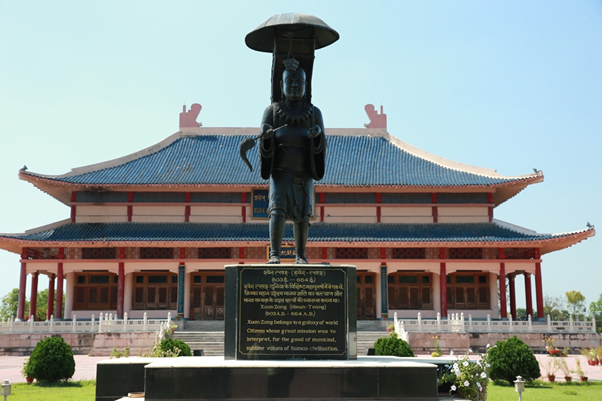 Xuan Zang Memorial Hall at Nalanda, India
Xuan Zang Memorial Hall at Nalanda, India
Vikramashila
Our next stop was Vikramashila University, which was one of the two most important centers of learning of Buddhadharma, besides Nalanda. Vikramashila fame spread, one of the reason was due to Acharya Dipamkara Srijnana stayed and taught here for a period of time and also served as its Academic Head (comparable to an education director or university rector).
Acharya Dipamkara Srijnana, who became known as Lama Atisha, was one of the alumni from Indonesia, i.e. Muarajambi. Studying under Acharya Dharmakirti, Dipamkara Srijnana lived and studied at Suwarnadwipa for 12 years. After studying in Indonesia, he returned to India and taught at Nalanda and Vikramashila, before he was invited to Tibet.
This trip left many deep impressions and insights; as if retracing in the footsteps of past great spiritual explorers who endeavored to master the Buddhadharma, as well as to preserve the teachings and culture that prevails to this very day. There was also a sense of happiness and gratitude for those who supported and facilitated this trip, especially to have been granted the opportunity to witness and get a direct, first-hand experience of these magnificent sites, which turned out to be so close to us, to Muarajambi and Indonesia.
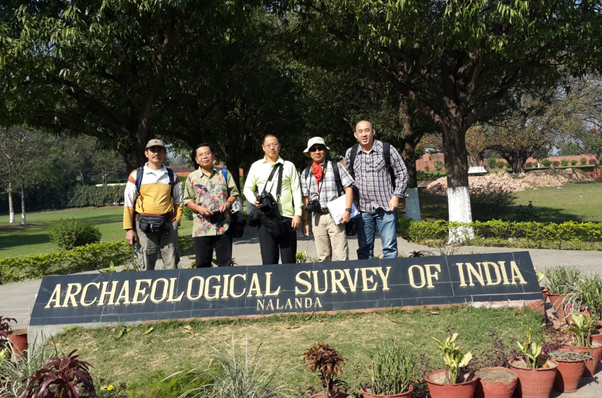 The trip to India with lecturers of the University of Indonesia. Dr. R. Cecep Eka Permana (far left), Prof. Dr. A. Aris Munandar (2nd from left), (Candidate Prof.) Agus Widiatmoko (4th from left).
The trip to India with lecturers of the University of Indonesia. Dr. R. Cecep Eka Permana (far left), Prof. Dr. A. Aris Munandar (2nd from left), (Candidate Prof.) Agus Widiatmoko (4th from left).
 Bahasa
Bahasa
 June 4th, 2015
June 4th, 2015  SUDIMUJA
SUDIMUJA 